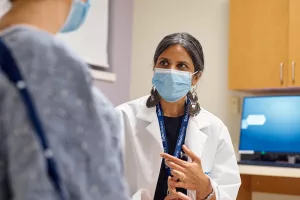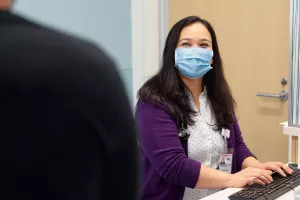Veins are part of a complex network of blood vessels that stretch for more than 60,000 miles in the adult human body. Whether you seek relief from painful varicose veins, treatment for a blocked vein or the removal of unsightly spider veins, our doctors will go the extra mile in treating your vascular condition.
Trusted medical + cosmetic treatments for healthy veins
About 34 major veins and many smaller veins connected to capillaries run through our bodies. From the big blue ones you can see on your arms and legs to the tiny venules that connect veins and capillaries, they all play an important role in delivering blood and other nutrients to different parts of your body. When the complex vein and vascular system isn’t working the way it should, it can have a big impact on your health and quality of life.
We specialize in minimally invasive treatments that help you feel better and boost your confidence, like laser therapy for varicose veins and spider veins.

Conditions
We detect, diagnose and treat both cosmetic and clinical vein conditions, like:
- Deep vein thrombosis (DVT)
- Chronic venous disease
- Iliac vein
- Pelvic venous syndrome
- Phlebitis and thrombophlebitis
- Restless leg syndrome
- Spider veins
- Varicose veins
- Venous stasis
- Venous ulcers
If you’re dealing with any of these conditions, we’re here to help you find the right treatment and get you feeling better.
If you’re experiencing any of the following symptoms, you may have a vein condition:
- A feeling of “heaviness” in your extremities
- Burning or itchy skin
- Leg or ankle swelling
- Pain, aching or cramping
- Restless legs
- Skin thickening and inflammation
- Ulcers
- Unsightly or bulging veins
Testing
When you come in for your first appointment, we will talk with you about your symptoms and any risk factors. Then, we'll do a clinical exam to check for vascular disease.
We’ll also schedule a simple, non-invasive test called a duplex ultrasound. This test uses sound waves to show us a clear picture of your veins, valves and how blood flows through them. By understanding how your veins work, we can see which ones need treatment.
Treatments
Once we’ve pinpointed your condition, we’ll work with you to create a treatment plan tailored to your unique needs. Most of our treatments are minimally invasive, which means you benefit from shorter procedures, less pain and quicker recovery times compared to other techniques. These treatments include:
- Laser ablation of dilated saphenous veins
- Laser treatment for spider veins
- Radiofrequency
- Recanalization and stenting for iliac, subclavian, innominate or venacaval obstruction
- Sclerotherapy for varicose veins and spider veins
- Vein valve transplantation and valve repair for deep venous reflux
- Vena cava filter placement and retrieval
- Venous bypass
We’re here to help you find the best treatment for your veins, whether it’s a minimally invasive procedure or vascular surgery, and ensure a smooth recovery.
When the valves of the great saphenous vein — one of the major veins in the lower half of your body — don’t close properly, blood flows in the wrong direction. This causes these veins and their nearby branches to expand and swell, creating varicose veins.
Varicose veins may lead to aching pain, throbbing and discomfort. They can also cause more serious problems, including skin ulcers or deep vein thrombosis, which is a blood clot in a deeper vein.
Ambulatory microphlebectomy for varicose veins
An ambulatory microphlebectomy is a smart treatment option when varicose veins are too large or close to the surface of the skin to be treated with other procedures like endovenous laser treatment or sclerotherapy. It’s typically performed with only local anesthesia, so you can leave our office the same day.
Here’s what to expect from an ambulatory microphlebectomy:
- Local anesthesia is used to numb the targeted area for the procedure, so you’ll be awake the whole time.
- Your surgeon makes incisions that are so small they usually don’t need stitches.
- Using surgical instruments, your surgeon delicately grasps and removes the veins with a hook-like tool through the incisions.
People can typically return to normal activity following the procedure.
Endovenous laser ablation
This minimally invasive technique uses laser therapy to treat superficial veins. The procedure takes about an hour to complete, and most people can return to normal activity afterward. Here’s how an endovenous laser ablation works:
- Local anesthesia is used to numb the affected area, typically around the knee.
- Your surgeon will then make a tiny incision to insert and guide a catheter to the affected vein using ultrasound imaging.
- A small laser fiber is threaded through the catheter to the diseased vein where it then emits heat energy to close and collapse the vein. As a result, the vein can no longer carry blood flow. Your body will absorb the collapsed vein over time as blood re-routes to other veins.
Laser treatment for varicose veins
Thanks to the power of lasers, we can treat varicose veins without making any incisions. These lasers target the problematic saphenous vein, causing it to shrink. This technique avoids the sometimes painful bruising and groin incisions associated with traditional techniques, which may cause a week or 2 of disability. With this approach, you’ll be back to your regular routine within a day or 2.
Sclerotherapy
This minimally invasive procedure is used to treat smaller varicose veins and spider veins. During the procedure, medicine is injected into the vein which causes the vein to shrink and disappear over time. The procedure takes approximately 15–30 minutes. Patients can typically return to normal activity following the procedure.
Venous ulcers form after a blockage in the leg reduces blood flow and causes high blood pressure within the veins. To treat venous ulcers, we numb the affected area with local anesthesia, then insert a stent (a small metal tube) in the veins to open them up, similar to the technique used in blocked heart vessels.
Spider veins are small, dilated blood vessels that appear close to the surface of the skin. They often look like a web of thin, reddish or purplish lines. Spider veins are usually harmless, although considered cosmetically undesirable for some people.
We offer a full range of state-of-the-art treatments for spider veins, including sclerotherapy and laser therapy. You don’t need a physician referral for spider vein treatment, and we can help set up an appointment for you.
Pelvic venous syndrome is a condition characterized by abdominal pain that gets worse during menstruation or sexual contact. This discomfort is caused by malfunctioning valves in the veins around the uterus and ovaries.
We have years of experience treating this complex condition. We typically use a catheter-based technique to block the problematic malfunctioning veins.

From regular office visits to inpatient stays, find the healthcare you need and deserve close to home.

Meet the doctors and care team devoted to supporting you every step of the way along your path to better health.